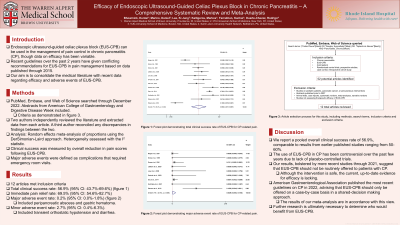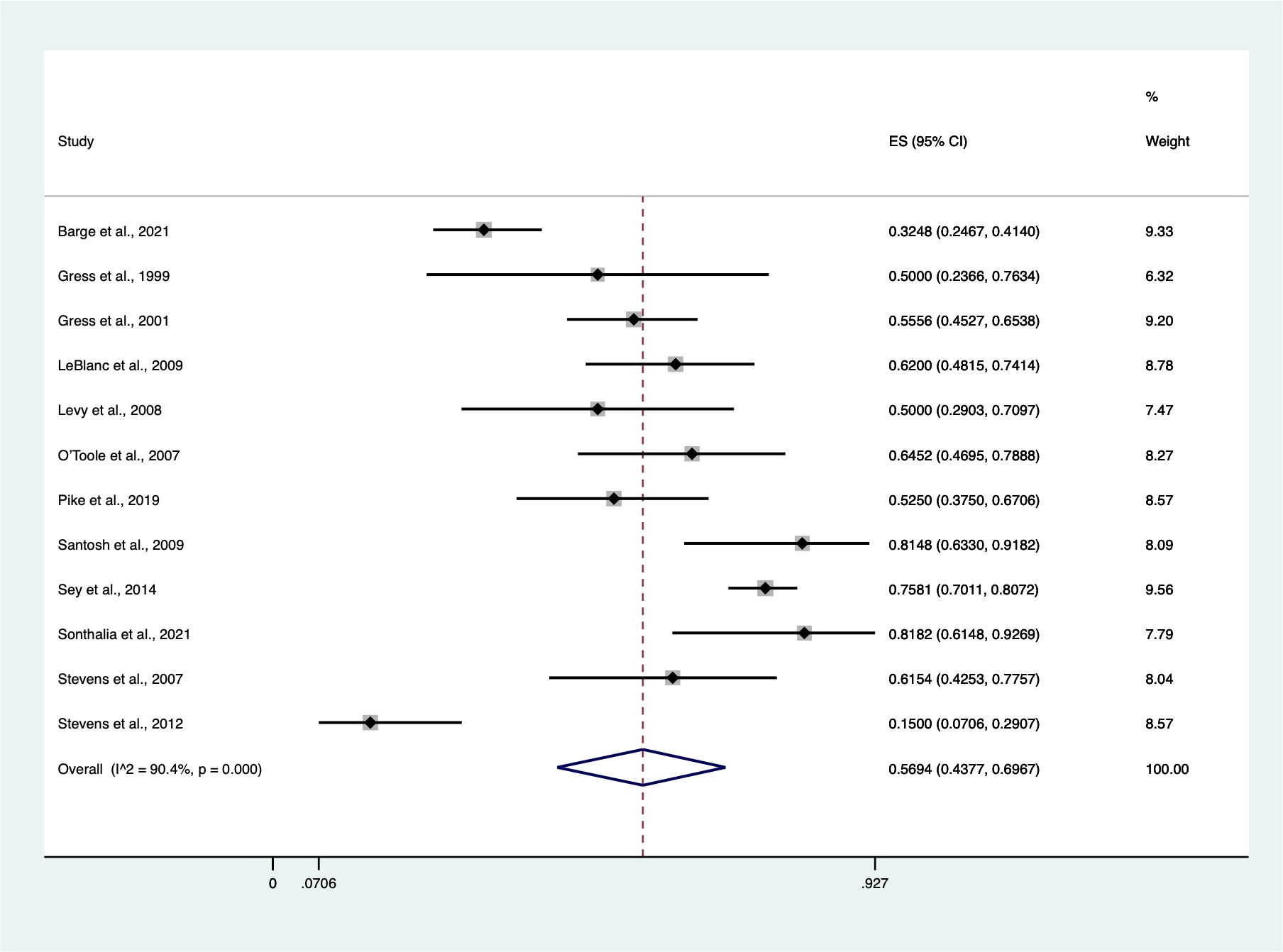Monday Poster Session
Category: Biliary/Pancreas
P1455 - Efficacy of Endoscopic Ultrasound-Guided Celiac Plexus Block in Chronic Pancreatitis: A Comprehensive Systematic Review and Meta-Analysis
Monday, October 23, 2023
10:30 AM - 4:15 PM PT
Location: Exhibit Hall

Has Audio
- KB
Kuntal Bhowmick, MD
The Warren Alpert Medical School of Brown University
Providence, RI
Presenting Author(s)
Kuntal Bhowmick, MD1, Daniel Marino, MD, MBA2, Ki Jung Lee, MD3, Markos Kalligeros, MD4, Kanhai Farrakhan, MD4, Rodrigo Duarte-Chavez, MD5
1The Warren Alpert Medical School of Brown University, Providence, RI; 2Brown University, Providence, RI; 3Tufts Medical Center, Harvard, MA; 4Warren Alpert Medical School of Brown University, Providence, RI; 5St. Luke’s University Health Network, Coopersburg, PA
Introduction: Endoscopic ultrasound-guided celiac plexus block (EUS-CPB) can be used in the management of pain control in chronic pancreatitis (CP), though data on efficacy has been variable. Recent guidelines over the past 2 years have given conflicting recommendations for EUS-CPB in pain management based on data published through 2015. We aim to consolidate the medical literature with recent data regarding efficacy and adverse effects of EUS-CPB.
Methods: A comprehensive literature search of PubMed, Embase, and Web of Science was performed through October 2022, including abstracts from Digestive Disease Week and American College of Gastroenterology. Studies that assessed the efficacy of EUS-CPB for CP were eligible for inclusion. Studies on pancreatic cancer or percutaneous interventions were excluded. Abstracts published prior to 2007, as well as any animal trials, case reports, systematic reviews, meta-analyses, or narrative reviews were also excluded. We performed a random effects meta-analysis of proportions using the DerSimonian-Laird approach. Heterogeneity among studies and subgroups was assessed with the I2 statistic. Clinical success was measured by overall reduction in pain scores following EUS-CPB. Major adverse events were defined as complications that required emergency room visits.
Results: A total of 12 articles met inclusion criteria from 681 potential articles. Most patients were found to require opiates for CP-related pain at the time of their respective studies. Total clinical success rate was 56.9% (95% CI: 43.7%-69.6%) (figure 1), immediate pain relief rate was 69.5% (95% CI: 54.6%-82.7%), major adverse event rate was 0.2% (95% CI: 0.0%-1.8%), and minor adverse event rate was 2.7% (95% CI: 0.4%-6.3%). Major adverse events included peripancreatic abscess and gastric hematoma. Minor adverse events included transient orthostatic hypotension and diarrhea.
Discussion: We report a pooled overall clinical success rate of 56.9%, comparable to results from earlier published studies ranging from 50-60%. The use of EUS-CPB in CP has been controversial over the past few years due to lack of placebo-controlled trials. Our findings and impressions are overall consistent with the most recent guidelines. Given significant morbidity associated with CP, a shared decision-making approach should be considered before potentially offering this intervention. Further research is ultimately necessary to determine who would benefit from EUS-CPB.

Disclosures:
Kuntal Bhowmick, MD1, Daniel Marino, MD, MBA2, Ki Jung Lee, MD3, Markos Kalligeros, MD4, Kanhai Farrakhan, MD4, Rodrigo Duarte-Chavez, MD5. P1455 - Efficacy of Endoscopic Ultrasound-Guided Celiac Plexus Block in Chronic Pancreatitis: A Comprehensive Systematic Review and Meta-Analysis, ACG 2023 Annual Scientific Meeting Abstracts. Vancouver, BC, Canada: American College of Gastroenterology.
1The Warren Alpert Medical School of Brown University, Providence, RI; 2Brown University, Providence, RI; 3Tufts Medical Center, Harvard, MA; 4Warren Alpert Medical School of Brown University, Providence, RI; 5St. Luke’s University Health Network, Coopersburg, PA
Introduction: Endoscopic ultrasound-guided celiac plexus block (EUS-CPB) can be used in the management of pain control in chronic pancreatitis (CP), though data on efficacy has been variable. Recent guidelines over the past 2 years have given conflicting recommendations for EUS-CPB in pain management based on data published through 2015. We aim to consolidate the medical literature with recent data regarding efficacy and adverse effects of EUS-CPB.
Methods: A comprehensive literature search of PubMed, Embase, and Web of Science was performed through October 2022, including abstracts from Digestive Disease Week and American College of Gastroenterology. Studies that assessed the efficacy of EUS-CPB for CP were eligible for inclusion. Studies on pancreatic cancer or percutaneous interventions were excluded. Abstracts published prior to 2007, as well as any animal trials, case reports, systematic reviews, meta-analyses, or narrative reviews were also excluded. We performed a random effects meta-analysis of proportions using the DerSimonian-Laird approach. Heterogeneity among studies and subgroups was assessed with the I2 statistic. Clinical success was measured by overall reduction in pain scores following EUS-CPB. Major adverse events were defined as complications that required emergency room visits.
Results: A total of 12 articles met inclusion criteria from 681 potential articles. Most patients were found to require opiates for CP-related pain at the time of their respective studies. Total clinical success rate was 56.9% (95% CI: 43.7%-69.6%) (figure 1), immediate pain relief rate was 69.5% (95% CI: 54.6%-82.7%), major adverse event rate was 0.2% (95% CI: 0.0%-1.8%), and minor adverse event rate was 2.7% (95% CI: 0.4%-6.3%). Major adverse events included peripancreatic abscess and gastric hematoma. Minor adverse events included transient orthostatic hypotension and diarrhea.
Discussion: We report a pooled overall clinical success rate of 56.9%, comparable to results from earlier published studies ranging from 50-60%. The use of EUS-CPB in CP has been controversial over the past few years due to lack of placebo-controlled trials. Our findings and impressions are overall consistent with the most recent guidelines. Given significant morbidity associated with CP, a shared decision-making approach should be considered before potentially offering this intervention. Further research is ultimately necessary to determine who would benefit from EUS-CPB.

Figure: Figure 1 - Total clinical success of EUS-CPB
Disclosures:
Kuntal Bhowmick indicated no relevant financial relationships.
Daniel Marino indicated no relevant financial relationships.
Ki Jung Lee indicated no relevant financial relationships.
Markos Kalligeros indicated no relevant financial relationships.
Kanhai Farrakhan indicated no relevant financial relationships.
Rodrigo Duarte-Chavez indicated no relevant financial relationships.
Kuntal Bhowmick, MD1, Daniel Marino, MD, MBA2, Ki Jung Lee, MD3, Markos Kalligeros, MD4, Kanhai Farrakhan, MD4, Rodrigo Duarte-Chavez, MD5. P1455 - Efficacy of Endoscopic Ultrasound-Guided Celiac Plexus Block in Chronic Pancreatitis: A Comprehensive Systematic Review and Meta-Analysis, ACG 2023 Annual Scientific Meeting Abstracts. Vancouver, BC, Canada: American College of Gastroenterology.
